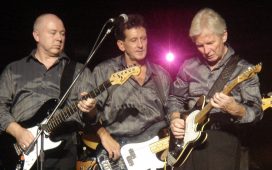By Mark Braboy
Just as 2019 has seen the growing dominance of visionary women in music like Billie Eilish, Megan Thee Stallion, and Kali Uchis, 1999 likewise set a glossy and explosive tone for the female future of hip-hop, R&B, and pop. On TV and radio, a litany of iconic visuals were on constant rotation: Missy Elliot’s “She’s a Bitch,” Britney Spears’s “…Baby One More Time” (still riding the wave of its ‘98 debut), and Destiny’s Child’s “Say My Name.” Mariah Carey, meanwhile, kicked off the era of the boldest album in her ‘90s catalog, Rainbow — which turns 20 this month — with twin statements: the captivating and mischievous “Heartbreaker” and the attitude-adjusting “Heartbreaker (Remix).”
Mariah’s boldness felt grounded in necessity. The then two-time Grammy-winning diva had written and recorded Rainbow during a rough and transformational period of her life. Over a year had passed since her nasty divorce from ex-husband/former Sony Music head Tommy Mottola, and she found herself at odds with the label as she continued to take more control of her sound and career. Yet her star continued to rise; “When You Believe,” her collaboration with Whitney Houston, won an Academy Award for Best Original Song in early 1999.
Mariah was also exposing more of herself to fans through her music, television interviews, and letters she posted to her website. She wrote candidly about her struggles in the industry, growing up as a biracial child, her tumultuous family life (as sung about on “Petals”), and making music for people who walked in her shoes. Out of those struggles came the most liberating and commercially successful album of her career at the time, despite its mixed reception from critics.
That liberation was right there in the name of the album. By Mariah’s account from a 1999 interview with Interview magazine, she came up with the title on a particularly rough day. “I was going into the studio in L.A., and there were two really clear rainbows, one on top of the other — I’d never seen that — and I was just having this really stressful day, which is standard for me,” she said. “But it was kind of indicative of my whole struggle, which is that there is light at the end of the tunnel, which hopefully is not a freight train.”
Finding that light at the end of the tunnel was the theme of Rainbow, a perfectly balanced musical tale of heartbreak and boot stomping. Mariah cut through with powerful ballads like the inspiring “Can’t Take That Away (Mariah’s Theme),” “Against All Odds (Take A Look at Me Now),” and “Thank God I Found You,” featuring 98 Degrees and Joe. But it was her heavy emphasis on hip-hop and R&B-infused tunes that led the charge, like the Usher-assisted “How Much.”
Her Billboard chart-smashing “Heartbreaker” with Jay-Z and its remix with Da Brat and Missy Elliott are remembered by fans as a joyous release from toxic romantic situations. “‘Heartbreaker’ was a nice record for me because at the time, I was dating a man and we broke up,” explained Jane, a Mariah fan since her self-titled 1990 debut. “For that song to be a happy version of a breakup song, it really did make an impact to where you felt better when you heard the song.”
After battling with Sony to make it a single, “Can’t Take That Away (Mariah’s Theme)” became one of Mariah’s most treasured Rainbow cuts, largely because it resonated with fans who had also experienced the adversities of being biracial. “My reality is that I grew up an interracial child,” Mariah said in a “lost” 1999 interview with an unnamed outlet that was preserved and uploaded on YouTube by fans. “The most important accomplishment that I made [is] when I read a card or a letter from a kid from Queens or wherever that says, ‘Thank you for giving me a role model as an interracial/mixed person [because] before you, I never knew that it was OK to be who I am. I never knew that I could make it or achieve what I achieved.’ When I was a little kid, I didn’t have that person who I identified with completely who made me feel like it was OK to be me.”
Keisha, a biracial woman from Chicago, found inspiration through Mariah’s own journey. “As a biracial woman, in general it’s hard to feel accepted. And I know a lot of people don’t think that because they assume, ‘Oh you’re light-skinned, you have good hair, you have it easy,’ and people put that on a pedestal. That’s only a portion of what you really go through. It’s hard to fit in when you’re only accepted in these different communities that you’re actually a part of when it’s convenient,” she said.
By enlisting a roster of hip-hop guests and collaborators — like Jermaine Dupri, DJ Clue and Ken “Duro” Ifill, Snoop Dogg, Jay-Z, Brian-Michael Cox, Kandi Burruss, and Craig B of No Limit’s Beats By Da Pound — Mariah also helped kick down the doors for rap music to be embraced within pop, even during Rainbow’s press run. She brought Da Brat with her when she took over an entire episode of TRL, and even performed “Heartbreaker (Remix)” alongside Missy on Oprah, which was unprecedented territory for hip-hop in the late ‘90s. Unsurprisingly, it resonated with and was a proud moment for young female hip-hop fans at the time.
“Mariah had broken so many barriers in that area and for us [young women] it was important. She used her sensuality in a coquettish way that wasn’t trashy and was more on the classy side with her album cover and music,” said Traci, a hip-hop lover who became a Mariah fan because of heavy rap infusion on Rainbow. “Also, watching the remix of ‘Heartbreaker’ meant a lot because it had all women. To have Da Brat and Missy together, that was huge because Mariah gets a lot of flack for having rappers appear [as guests], and she was like, ‘Well I’ma take it a step further and do all ladies.’”
Today, Rainbow’s themes of growing into yourself and finding the glow-up from heartbreak — while fusing pop with hip-hop and R&B — live on. Its resonance can be heard and felt in Ariana Grande’s thank u, next, Kehlani’s SweetSexySavage, and even Summer Walker’s Over It. And for others, the album’s lessons are still kept close to heart.
“We got to see a different side of Mariah [on Rainbow], and I think that was empowering for a lot of people because she touched on so many things that were important to us as women without saying it,” Keishia said. “We have to find strength in so many different avenues because we don’t always get that from people around us or our careers, families, or the people we’re in relationships with. Rainbow resonated in my spirit as one of those things that was going to help me build myself to the kind of woman that I wanted to be.”














